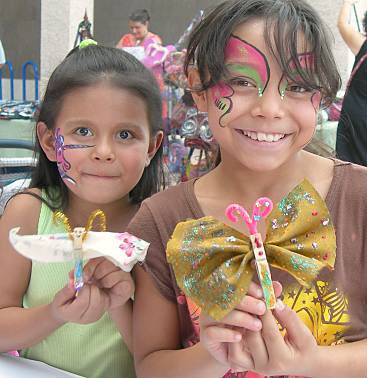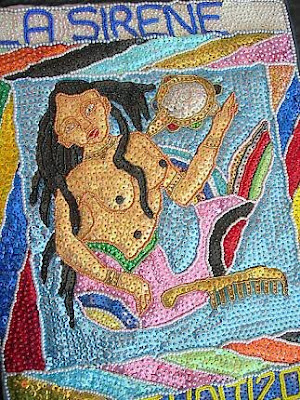 I fell in love with the transparent sea green AB sequins -- you should have seen them in the bright indirect light under the tent!
I fell in love with the transparent sea green AB sequins -- you should have seen them in the bright indirect light under the tent!
 I fell in love with the transparent sea green AB sequins -- you should have seen them in the bright indirect light under the tent!
I fell in love with the transparent sea green AB sequins -- you should have seen them in the bright indirect light under the tent!
 Yay, woohoo! I get to teach my earring wires class just before the Fall semester starts (when Persephone gets hauled back into the underworld, {sigh}.
Yay, woohoo! I get to teach my earring wires class just before the Fall semester starts (when Persephone gets hauled back into the underworld, {sigh}.~~~~~~~~~~

This week at Summerfest I finally remembered to bring an actual camera instead of just a cell phone. Much better results! I loved photographing our visitors, and they seemed to enjoy being photographed (adults, and kids with parents' permission of course).
As I was editing the photos I especially noticed the eyes and the hands. Most adults hate having their picture taken -- but the kids looked right into the camera and seemed to smile straight from the heart. How joyous and proud artmaking makes them feel!
The hand gestures -- I actually noticed those while I was shooting because it's one way you can tell how engaged a child is in their work. See how these sisters hold their butterflies? Like mudras? I just love the unselfconscious gestures and all the others I witnessed Saturday night. (See OFFCenter's blog for more photos.)
By the way, did you notice how perfectly these girls' butterflies coordinate with their face paint and outfits? OMG, fashionistas in the making!


Most of this flag was executed in spot stitch, with the cupped sequins facing down, attached with seed beads in the same colors as the sequins. It looked to me as though the seed bead outlines were sewn on after the sequins.
Recently I found this nice blog article about Haitian sequined flags, as well as a link to an exhibition of Vodou-related artwork at the American Museum of Natural History, so check them out to learn more about the flags (drapo). And you can even purchase George Valris' very reasonably priced work at the sister site of the SFIFAM.
 These are foldover notes made from an old map and some discarded masking sheets. Masking sheets are used to align the film negatives before burning a plate to be hung on a printing press.
These are foldover notes made from an old map and some discarded masking sheets. Masking sheets are used to align the film negatives before burning a plate to be hung on a printing press. These are not envelopes per se and they don't need glue -- you cut a slit in them to tuck the flap into. I suppose you could put something inside, but you'd probably need to tape the flap shut.
These are not envelopes per se and they don't need glue -- you cut a slit in them to tuck the flap into. I suppose you could put something inside, but you'd probably need to tape the flap shut. See?
See? I got the template from Mirkwood Designs. (It's called the "postage stamp" envelope.) I printed it onto sturdy index stock and cut it out and I've used the template for a few years already!
I got the template from Mirkwood Designs. (It's called the "postage stamp" envelope.) I printed it onto sturdy index stock and cut it out and I've used the template for a few years already!
I took this shot last night outside the OFFCenter studio to help Marcia Sednek (our lovely model) show off a new fundraising item for this hoppin' little community arts project. The bags are made of recycled plastic shopping bags and each one is unique. You can read more about them on the OFFCenter blog.
Also, I probably should mention that Marcie's show, "Frock On," at Mariposa is coming down soon, so get on over there quickly if you haven't seen it. She does fashionable things with recycled metal -- and by that I mean she makes doll sized dresses out of old tins and such. Yes, the dresses in the photo below are made of metal.

~~~~~~~~~~
 It's been forever since I put up a poll on my blog. I really enjoy them. This one asks . . .
It's been forever since I put up a poll on my blog. I really enjoy them. This one asks . . .
 P.S. To keep myself totally honest, I took "before" photos of my studio. But there is no way I'm posting them here! Maybe alongside the "after" photos. Maybe. Until then, the MOTH can always blackmail me with them, LOL!
P.S. To keep myself totally honest, I took "before" photos of my studio. But there is no way I'm posting them here! Maybe alongside the "after" photos. Maybe. Until then, the MOTH can always blackmail me with them, LOL!

 Margie Deeb sent me an email to let me know that my Shepherdess Angel necklace had been featured in her July color theory newsletter, Margie's Muse. Cool! And thanks, Margie.
Margie Deeb sent me an email to let me know that my Shepherdess Angel necklace had been featured in her July color theory newsletter, Margie's Muse. Cool! And thanks, Margie. Another photo from the Santa Fe International Folk Art Market (this could go on for days you know . . .). This is Claudia Vargas and she was SO funny. She makes art, such as retablos, from recycled materials. She is a veteran of the market, and she brought a basket full of "cameras" made of beer cans, wire, etc. When you move a wire, the camera pops open -- and out -- to reveal a silly face.
Another photo from the Santa Fe International Folk Art Market (this could go on for days you know . . .). This is Claudia Vargas and she was SO funny. She makes art, such as retablos, from recycled materials. She is a veteran of the market, and she brought a basket full of "cameras" made of beer cans, wire, etc. When you move a wire, the camera pops open -- and out -- to reveal a silly face.This is the awesome booth of designs from the cooperative of , I think Ann said, about a dozen women. I noticed that both young women and older women were trying on the collars, each one finding just the perfect design for their wardrobe and personality.
Ann (above) is one of two beaders that I know of (there may be more, if so let me know and I'll link to them here) who do not just reverse engineer the Saraguro designs and techniques for their own benefit, but who contribute significantly to the Saraguro cooperatives. Ann teaches some of the Saraguro designs and patterns, and sends a portion of her income from that back to the Saraguro cooperatives.
Chris Prussing from Juneau, Alaska, sells her tutorials (last I checked there were about 15 of them!) of Saraguro designs on bead-patterns.com and donates half the money from sales directly back to the four Saraguro beading cooperatives.
(FYI, there are now patterns and designs available that mention "Saraguro" but they are only "inspired by" the designs and they don't use the traditional stitching. Not being fussy, I just mention this because the above designers have been to Ecuador and taken classes from the women, use their very unique stitching techniques, and donate directly back to the coops.)
Income from the Folk Art Market and donations from Chris and Ann (among others I'm sure) have had a significant impact on the Saraguro women's lives. They have literally built housing for their cooperative, maintain a healthy bank account which is used for micro-loans to themselves, so that they can get bulk pricing on beads and supplies, and of course derive an income for their families.
I might never get to Ecuador, but I was happy to meet Zoila and see how she and her coop partners are taking control of their craft, on an international scale.
P.S. If I got any info wrong in this post, it's all my fault, LOL! Ann shared a lot of info with me but I wasn't exactly taking notes. ;-)

So, can you spot the volunteer in these photos? ;-) Just kidding -- she was such a sweetheart, and so willing, I couldn't resist taking her picture too. The two women artisans are from different places in Bolivia. The woman sitting on the ground is an Ayoreo Indian. She is making clothing and purses by needle weaving pounded bromeliad fibers.
The volunteer, I was told when I paid for a little plate from Uzbekistan, was one of a whopping 1,400 who help at the event, handling everything from parking to payments to assisting artists in their booths, an especially gracious touch that helps to bridge cultural and language barriers.
~~~~~~~~~~
 Sarah and I met up in Santa Fe to go to the International Folk Art market tomorrow. Here we are at the Econolodge. Sarah says the curtains look like William Morris on bad acid. It might be hard to tell in the photo (and if so I'll be embarassed for saying this) but it looks like there is something in the valance that's giving the finger to something up above it.
Sarah and I met up in Santa Fe to go to the International Folk Art market tomorrow. Here we are at the Econolodge. Sarah says the curtains look like William Morris on bad acid. It might be hard to tell in the photo (and if so I'll be embarassed for saying this) but it looks like there is something in the valance that's giving the finger to something up above it.



